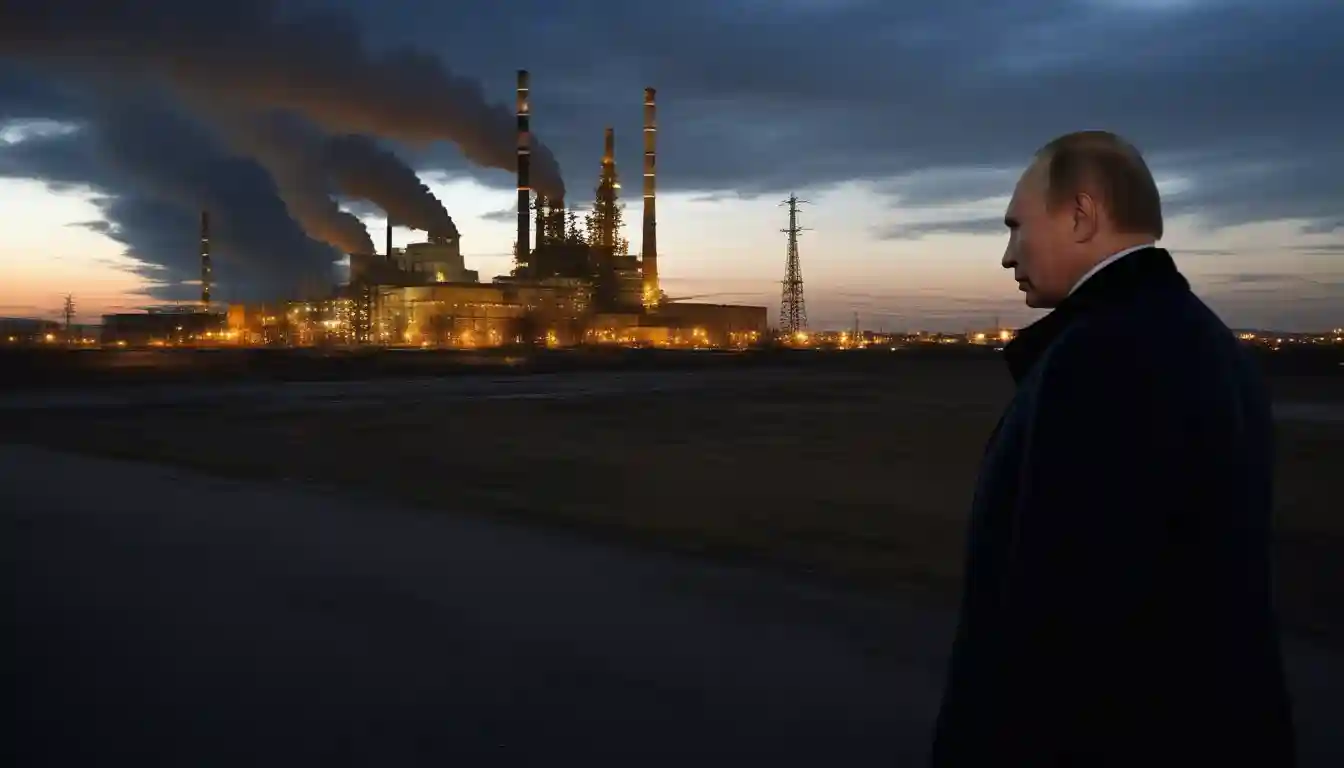
Putin Says US-Russia Relations Show Light at End of Tunnel During Nuclear City Visit After Trump Alaska Meeting
Nuclear Diplomacy at the Crossroads: Putin's Sarov Gambit Signals Strategic Recalibration
SAROV, Russia — On August 22, Vladimir Putin arrived in Sarov, the closed nuclear city in Russia's Nizhny Novgorod region that has remained largely hidden from public view since the Soviet era. The Russian president's visit marked the 80th anniversary of Russia's nuclear industry, bringing him face-to-face with nuclear physicists and industry experts at the Federal Nuclear Center—the same facility where Soviet scientists developed the USSR's first atomic weapons.

During his time in Sarov, Putin toured exhibits showcasing the scientific and educational infrastructure of Russia's key nuclear research towns, including Sarov, Snezhinsk, Lesnoy, Zheleznogorsk, and Obninsk. In a ceremonial moment that underscored the historical weight of the location, he laid flowers at the monument to Yuly Khariton, the first scientific director of the Soviet nuclear program who led the development of the Soviet Union's atomic arsenal.
The visit came just one week after Putin's August 15 summit with President Trump at Joint Base Elmendorf-Richardson in Anchorage, Alaska—a meeting that broke years of frozen high-level diplomatic contact between the two nations. Speaking to nuclear scientists and industry workers at Sarov's House of Scientists, Putin characterized the recent diplomatic engagement in notably optimistic terms.
"There is light at the end of the tunnel," Putin stated, describing his Alaska meeting with Trump as "meaningful and frank." He went further, floating the possibility of joint projects between Russia and the United States in the Arctic and even within Alaska itself. The timing and location of these remarks—delivered within Russia's most sensitive nuclear research facility—created an unmistakable juxtaposition between military capability and economic cooperation.
This convergence of nuclear symbolism and diplomatic messaging sets the stage for understanding broader shifts in global energy markets, where Russia's nuclear fuel dominance intersects with mounting Western pressure for supply chain independence.
The Sarov Symbolism
The choice of venue carried profound meaning. Sarov, formerly known as Arzamas-16, remains one of Russia's most restricted cities, where Yuly Khariton led the development of the Soviet Union's first atomic bomb. Putin's tour of exhibits showcasing nuclear research towns—from Sarov to Snezhinsk, Lesnoy to Zheleznogorsk—underscored Russia's continued dominance in nuclear technology and fuel production.
A "closed city" is a settlement with significant restrictions on travel and residency, a concept strongly associated with the Soviet Union and modern-day Russia. Officially known as ZATO (Closed Administrative-Territorial Formations), these towns were often secret and housed sensitive military or nuclear research facilities, such as the famous nuclear center in Sarov (formerly Arzamas-16).
During meetings with nuclear scientists and industry workers, Putin laid out an ambitious vision for continued cooperation with Western nations. According to multiple sources familiar with the discussions, he indicated Russia would maintain nuclear fuel supplies and services to international partners at levels approaching pre-conflict scales, despite ongoing sanctions pressure.
The message resonated immediately through global energy markets. The Global X Uranium ETF surged 6.0% to $39.44, with intraday volume reaching 4.8 million shares—nearly triple the recent average—as investors recalibrated expectations for nuclear fuel supply chains.
The intraday price and volume movement for the Global X Uranium ETF (URA) on August 22, 2025, showing a significant spike.
| Time (ET) | Price (USD) | Volume |
|---|---|---|
| 09:30 AM | 37.18 | 500,000 |
| 11:00 AM | 38.50 | 1,200,000 |
| 02:45 PM | 39.58 | 2,500,000 |
Alaska Afterglow and Arctic Ambitions
Putin's comments built upon momentum from his unexpected meeting with Trump at Joint Base Elmendorf-Richardson in Anchorage, where the leaders engaged in what sources described as frank discussions about Ukraine and broader U.S.-Russia relations. While no concrete agreements emerged from the Alaska summit, the diplomatic thaw created space for economic messaging that Moscow has been eager to exploit.
The Russian president specifically referenced potential cooperation in Arctic development and even Alaska-based projects, dangling economic carrots to amplify narratives of renewed partnership. Energy analysts suggest this reflects Moscow's strategy to leverage its nuclear expertise as a pathway back into Western markets, circumventing broader sanctions regimes.
"Putin understands that nuclear cooperation represents one of the few remaining bridges between Russia and the West," observed a senior analyst at a major investment bank who requested anonymity due to the sensitivity of U.S.-Russia relations. "The technical expertise and infrastructure dependencies create mutual vulnerabilities that both sides are reluctant to fully sever."
Market Realities Versus Political Rhetoric
Yet the economic reality proves more complex than Putin's optimistic projections suggest. The Prohibiting Russian Uranium Imports Act, signed into U.S. law, fundamentally restricts Russian nuclear fuel imports, with Department of Energy waivers available only through 2028 to prevent power plant disruptions.
Sources of U.S. Uranium Imports by Country. This chart illustrates the dependency of the U.S. on foreign uranium, including from Russia, prior to the import ban.
| Country | Share of U.S. Uranium Purchases (2022) |
|---|---|
| Canada | 27% |
| Kazakhstan | 25% |
| Russia | 12% |
| Uzbekistan | 11% |
| Australia | 9% |
| Other Countries | 16% |
European Union utilities face their own diversification pressures. Czech energy giant ČEZ recently received its first VVER reactor fuel reloads from Westinghouse, marking a significant milestone in reducing dependence on Russian nuclear services. Bulgaria maintains limited exemptions while progressing toward Western alternatives, reflecting the gradual but persistent shift away from Rosatom's dominance.
This structural transformation has created substantial opportunities for Western nuclear fuel companies. Centrus Energy, with its unique early positioning in High-Assay Low-Enriched Uranium (HALEU) production, has seen its strategic value increase as the Department of Energy extends production contracts through mid-2026. Similarly, Cameco's integrated uranium and conversion capabilities have benefited from strengthening long-term contracting activity.
High-Assay Low-Enriched Uranium (HALEU) is a type of nuclear fuel that is more enriched than the fuel used in existing reactors. It is essential for powering many advanced nuclear reactor designs, enabling them to be smaller and more efficient, and companies like Centrus Energy are now beginning its commercial production.
Investment strategists increasingly view the nuclear fuel sector through the lens of strategic competition rather than purely commercial dynamics. "We're witnessing the weaponization of energy interdependence," noted a portfolio manager specializing in critical materials. "That creates both risks and opportunities that traditional market analysis often misses."
The Diversification Imperative
European utilities operating Soviet-designed VVER reactors face particularly acute challenges in balancing economic efficiency with energy security. While Rosatom remains largely unsanctioned by EU authorities, political pressure for diversification continues mounting across member states.
The Czech Republic's successful transition to Westinghouse fuel assemblies provides a template for other nations, though technical complexities and regulatory requirements ensure gradual implementation timelines. Hungary's continued reliance on Russian nuclear services for its Paks II project represents a notable outlier, maintaining closer Moscow ties that create ongoing geopolitical risk premiums.
These dynamics have profound implications for global nuclear fuel markets. Western enrichment and conversion capacity, deliberately expanded through recent U.S. government investments exceeding $2.7 billion, positions American and allied companies to capture market share as traditional Russian relationships evolve.
Arctic Mirage and Sanctions Reality
Putin's references to Arctic cooperation, while diplomatically significant, face substantial practical constraints. Arctic LNG 2, Russia's flagship liquefied natural gas project, continues operating under comprehensive sanctions despite sporadic cargo movements using shadow fleet tankers.
Energy market participants remain skeptical that diplomatic engagement will translate into meaningful sanctions relief for Russian energy exports. The legal architecture constraining Russian natural gas and nuclear fuel trade reflects congressional mandates that transcend executive branch flexibility.
"The infrastructure for U.S.-Russia energy cooperation has been systematically dismantled over three years," explained a former State Department official now working in private sector energy consulting. "Rebuilding those relationships requires legislative action, not just diplomatic gestures."
Investment Implications and Forward Outlook
The Sarov visit and Putin's subsequent messaging create several potential scenarios for energy markets over the coming months. Investment analysts suggest three primary pathways warrant consideration.
A "thaw-lite" scenario envisions continued diplomatic dialogue without fundamental sanctions architecture changes, maintaining current legal restrictions while allowing selective commercial engagement in unsanctioned sectors. This outcome would benefit Western nuclear fuel companies through sustained diversification demand while limiting Russian market access.
Alternatively, talks could deteriorate if broader geopolitical tensions resurface, potentially accelerating European moves toward comprehensive Rosatom restrictions. Such developments would significantly strengthen Western fuel-cycle companies while increasing near-term supply chain pressures.
A third possibility involves symbolic economic cooperation agreements that generate positive headlines without meaningful policy changes. Market participants should remain cautious about relief rallies in Russian energy assets, given persistent legal and political constraints.
Financial advisors recommend positioning portfolios to benefit from structural shifts toward Western nuclear fuel supply chains while maintaining hedges against geopolitical volatility. Companies with HALEU capabilities and integrated uranium operations appear particularly well-positioned for sustained demand growth.
The nuclear fuel sector's evolution reflects broader themes of economic nationalism and strategic competition that transcend traditional market dynamics. Putin's Sarov visit, while rich in symbolism, cannot overcome the fundamental reality that Western nations increasingly view energy security through the lens of national security—a transformation that creates both challenges and opportunities for investors willing to navigate this complex landscape.
As the 80th anniversary of Russia's nuclear industry unfolds, the atomic age's promise of peaceful cooperation confronts 21st-century realities of strategic competition. The outcome will reshape not just energy markets, but the broader architecture of global economic interdependence.
NOT INVESTMENT ADVICE